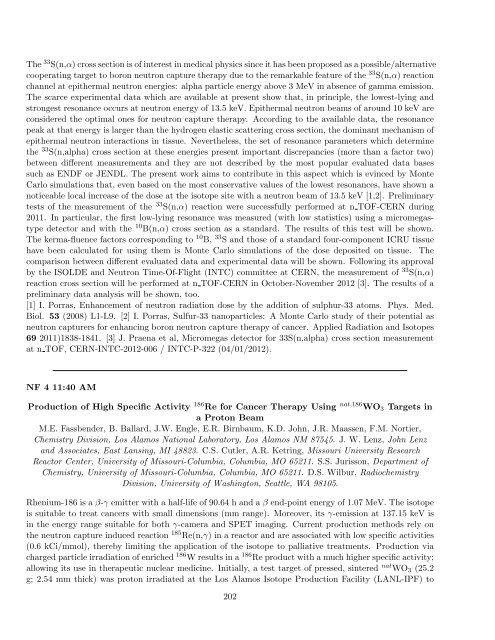Program - Brookhaven National Laboratory
Program - Brookhaven National Laboratory
Program - Brookhaven National Laboratory
Create successful ePaper yourself
Turn your PDF publications into a flip-book with our unique Google optimized e-Paper software.
The 33 S(n,α) cross section is of interest in medical physics since it has been proposed as a possible/alternative<br />
cooperating target to boron neutron capture therapy due to the remarkable feature of the 33 S(n,α) reaction<br />
channel at epithermal neutron energies: alpha particle energy above 3 MeV in absence of gamma emission.<br />
The scarce experimental data which are available at present show that, in principle, the lowest-lying and<br />
strongest resonance occurs at neutron energy of 13.5 keV. Epithermal neutron beams of around 10 keV are<br />
considered the optimal ones for neutron capture therapy. According to the available data, the resonance<br />
peak at that energy is larger than the hydrogen elastic scattering cross section, the dominant mechanism of<br />
epithermal neutron interactions in tissue. Nevertheless, the set of resonance parameters which determine<br />
the 33 S(n,alpha) cross section at these energies present important discrepancies (more than a factor two)<br />
between different measurements and they are not described by the most popular evaluated data bases<br />
such as ENDF or JENDL. The present work aims to contribute in this aspect which is evinced by Monte<br />
Carlo simulations that, even based on the most conservative values of the lowest resonances, have shown a<br />
noticeable local increase of the dose at the isotope site with a neutron beam of 13.5 keV [1,2]. Preliminary<br />
tests of the measurement of the 33 S(n,α) reaction were successfully performed at n TOF-CERN during<br />
2011. In particular, the first low-lying resonance was measured (with low statistics) using a micromegastype<br />
detector and with the 10 B(n,α) cross section as a standard. The results of this test will be shown.<br />
The kerma-fluence factors corresponding to 10 B, 33 S and those of a standard four-component ICRU tissue<br />
have been calculated for using them is Monte Carlo simulations of the dose deposited on tissue. The<br />
comparison between different evaluated data and experimental data will be shown. Following its approval<br />
by the ISOLDE and Neutron Time-Of-Flight (INTC) committee at CERN, the measurement of 33 S(n,α)<br />
reaction cross section will be performed at n TOF-CERN in October-November 2012 [3]. The results of a<br />
preliminary data analysis will be shown, too.<br />
[1] I. Porras, Enhancement of neutron radiation dose by the addition of sulphur-33 atoms. Phys. Med.<br />
Biol. 53 (2008) L1-L9. [2] I. Porras, Sulfur-33 nanoparticles: A Monte Carlo study of their potential as<br />
neutron capturers for enhancing boron neutron capture therapy of cancer. Applied Radiation and Isotopes<br />
69 2011)1838-1841. [3] J. Praena et al, Micromegas detector for 33S(n,alpha) cross section measurement<br />
at n TOF, CERN-INTC-2012-006 / INTC-P-322 (04/01/2012).<br />
NF 4 11:40 AM<br />
Production of High Specific Activity 186 Re for Cancer Therapy Using nat,186 WO3 Targets in<br />
a Proton Beam<br />
M.E. Fassbender, B. Ballard, J.W. Engle, E.R. Birnbaum, K.D. John, J.R. Maassen, F.M. Nortier,<br />
Chemistry Division, Los Alamos <strong>National</strong> <strong>Laboratory</strong>, Los Alamos NM 87545. J. W. Lenz, John Lenz<br />
and Associates, East Lansing, MI 48823. C.S. Cutler, A.R. Ketring, Missouri University Research<br />
Reactor Center, University of Missouri-Columbia, Columbia, MO 65211. S.S. Jurisson, Department of<br />
Chemistry, University of Missouri-Columbia, Columbia, MO 65211. D.S. Wilbur, Radiochemistry<br />
Division, University of Washington, Seattle, WA 98105.<br />
Rhenium-186 is a β-γ emitter with a half-life of 90.64 h and a β end-point energy of 1.07 MeV. The isotope<br />
is suitable to treat cancers with small dimensions (mm range). Moreover, its γ-emission at 137.15 keV is<br />
in the energy range suitable for both γ-camera and SPET imaging. Current production methods rely on<br />
the neutron capture induced reaction 185 Re(n,γ) in a reactor and are associated with low specific activities<br />
(0.6 kCi/mmol), thereby limiting the application of the isotope to palliative treatments. Production via<br />
charged particle irradiation of enriched 186 W results in a 186 Re product with a much higher specific activity;<br />
allowing its use in therapeutic nuclear medicine. Initially, a test target of pressed, sintered nat WO3 (25.2<br />
g; 2.54 mm thick) was proton irradiated at the Los Alamos Isotope Production Facility (LANL-IPF) to<br />
202
















